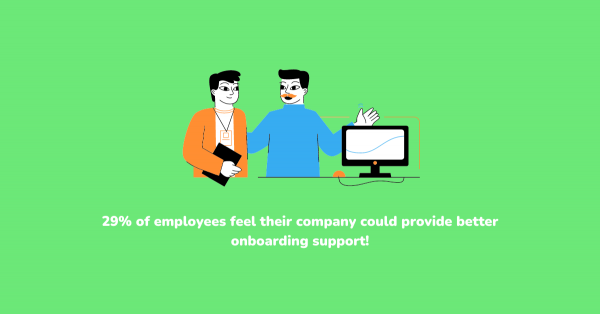Running a small business comes with its own set of challenges, especially when it comes to managing employees effectively. That's where onboarding software can make a significant difference. By streamlining the employee onboarding process, small businesses can save time, improve employee morale, and boost productivity right from day one.
Specialized software for small businesses provides a structured and automated approach to the process. With features like electronic document signing, task management, and employee self-service portals, it simplifies the process for both HR teams and new hires. But why should small businesses invest in specialized software? Well, for starters, it eliminates the need for manual paperwork, which can be time-consuming and prone to errors. Additionally, this software ensures compliance with legal regulations, such as tax forms and employment agreements, so you can focus on growing your business instead of worrying about paperwork.
Moreover, the software enhances the employee experience by creating a seamless, efficient, and personalized process. It allows you to customize the process according to your company's unique needs, ensuring that new hires feel welcomed, supported, and equipped with the resources they need to succeed.
In short, specialized software is a game-changer for small businesses, making the process more efficient, engaging, and impactful and retaining your key employees. So, if you're looking to optimize your process and set your small business up for success, investing in specialized software is a smart choice.
The Importance of Onboarding for Small Businesses
Effective onboarding is a critical process for small businesses, as it sets the tone for a new employee's experience and helps them integrate seamlessly into the company. Effectively planning and introducing a new employee can have a significant impact on an employee's productivity, job satisfaction, and long-term retention.
Benefits of Effective Onboarding for Small Businesses

Improved Employee Satisfaction and Retention
- Welcoming Atmosphere - A well-structured process creates a positive first impression, making new hires feel valued and welcomed.
- Enhanced Engagement - When employees feel connected to the company's mission and values, they are more likely to be engaged and motivated.
- Reduced Turnover - A positive experience can foster a sense of loyalty and commitment, reducing employee turnover rates.
Increased Productivity and Efficiency
- Faster Ramp-Up Time - The process ensures that new hires have the necessary training and resources to start contributing to the team quickly.
- Improved Performance - When employees understand their roles and responsibilities, they can perform their tasks more efficiently and effectively.
- Reduced Errors - Clear guidelines and support during the process can help prevent mistakes and misunderstandings.
Stronger Company Culture
- Alignment with Values - These programs can reinforce the company's culture and values, ensuring that new employees understand and embody them.
- Positive Work Environment - A positive experience can contribute to a positive and supportive work environment.
- Increased Employee Morale - When employees feel valued and appreciated, they are more likely to have high morale and job satisfaction.
Enhanced Brand Reputation
- Positive Employer Branding - A positive experience can enhance a company's reputation as an employer of choice.
- Attracting Top Talent - A strong process can help attract and retain top-quality talent.
Challenges Faced by Small Businesses
While the importance of onboarding is well-recognized, small businesses often face unique challenges in implementing an effective program. Limited resources, both in terms of time and budget, can make it difficult to develop and maintain a comprehensive process.
Limited Resources
- Time Constraints - Small businesses often have limited time to dedicate, as they are focused on day-to-day operations.
- Budget Restrictions - A lack of budget can hinder the development and implementation of comprehensive programs.
Lack of HR Expertise
- Ad-Hoc Approach - Without dedicated HR personnel, it may be handled in an ad-hoc or inconsistent manner.
- Missed Opportunities - A lack of expertise can lead to missed opportunities for employee engagement and retention.
Balancing the Process with Other Priorities:
- Secondary Concern - It may be viewed as a secondary concern, especially during busy periods.
- Suboptimal Experience - New employees may feel neglected or unsupported if the process is not given adequate attention.
Scalability Issues
- Growth Challenges - As small businesses grow, their processes may become overwhelmed or inefficient.
- Consistency Issues - Maintaining consistency in the process can be difficult as the company expands.
Cultural Differences
- Global Challenges - For small businesses with a global workforce, cultural differences can present unique challenges.
- Effective Adaptation - Adapting processes to accommodate cultural nuances is essential for success.
Technological Limitations
- Outdated Systems - Small businesses may lack the necessary technology or tools to support a modern process.
- Integration Challenges - Integrating these systems with other HR functions can be complex.
Competitive Pressure
- Time-to-Market - The need to quickly bring new employees up to speed can create pressure on processes.
- Talent Acquisition - Attracting and retaining top talent requires a competitive experience.
Key Features to Consider
When selecting the right software for your small business, it's essential to consider the specific features that will best meet your needs and streamline the process. Some key features to look for include:
- Customizable Workflows - The ability to tailor the process to your company's unique needs, including the ability to create custom checklists, tasks, and milestones.
- Electronic Document Signing - The capability to digitally collect and store important documents, such as employment agreements, tax forms, and non-disclosure agreements.
- Automated Task Management - A system that automatically assigns and tracks these tasks, ensuring that new hires receive the necessary training, resources, and support.
- Employee Self-Service Portal - A user-friendly platform that allows new hires to access relevant information, complete tasks, and communicate with the HR team.
- Reporting and Analytics - The ability to generate reports and analyze the data, helping you identify areas for improvement and measure the effectiveness of your program.
- Integrations with Other HR Systems - The capability to seamlessly integrate with your existing HR software, such as payroll or HR information systems, to streamline data management and ensure a cohesive employee experience.
By prioritizing these key features, small businesses can find a software solution that not only enhances the process but also aligns with their overall HR strategy and business objectives.
How to Choose the Right Software

Selecting the right software for your small business can be a daunting task, given the wide range of options available. To make an informed decision, it's essential to carefully assess your specific needs and requirements. Here are some key steps to guide you in the selection process:
- Define Your Goals and Pain Points - Start by identifying the primary challenges and pain points in your current process. This will help you determine the specific features and functionalities you need in a software solution.
- Evaluate the Software's Features and Capabilities - Carefully review the features offered by different software providers, ensuring they align with your goals and requirements. Consider factors like customization, task management, document management, and reporting capabilities.
- Assess the User Experience and Ease of Use - Look for software that offers a user-friendly interface, intuitive navigation, and a seamless experience for both HR teams and new hires. This will help ensure a smooth and efficient process.
- Consider Integration Capabilities - Evaluate the software's ability to integrate with your existing HR systems, such as payroll, HRIS, or applicant tracking software. This will help create a cohesive and streamlined employee experience.
- Prioritize Scalability and Flexibility - As your small business grows, your needs may change. Look for a solution that can scale with your organization and adapt to your evolving requirements.
- Analyze Pricing and Cost-Effectiveness - Compare the pricing models and overall cost-effectiveness of different software options, taking into account features, user licenses, and any additional implementation or support fees.
- Seek Customer Reviews and References - Reach out to other small businesses that have implemented the software you're considering and get their feedback on the product's performance, ease of use, and customer support.
By following these steps, you can make an informed decision and choose the software that best fits your small business's needs, ultimately enhancing the experience for your new hires and driving long-term success.
Implementing Onboarding Software
Implementing the software in your small business requires careful planning and execution. Start by assessing your current process and identifying areas for improvement. Consider factors such as the time and resources required, the pain points experienced by new hires and HR teams, and the overall effectiveness of your program.
Once you've identified your needs, research and evaluate different software options to find the best fit for your business. Look for software that aligns with your budget, company size, and industry-specific requirements.
When it comes to the implementation process, it's essential to involve key stakeholders, such as HR, IT, and management, to ensure a smooth rollout. Provide comprehensive training to your HR team on how to use the software, and communicate the benefits of the new process to new hires and existing employees.
Tips for Successfully Using the Software
An effective experience using software goes beyond simply implementing the technology. To ensure a successful experience, consider the following tips:
- Customize the Process - Tailor the experience to your company's unique culture, values, and job roles. This will help new hires feel more engaged and aligned with your organization.
- Encourage Ongoing Feedback - Regularly solicit feedback from new hires and HR teams to identify areas for improvement and continuously optimize the process.
- Integrate with Other HR Systems - Seamlessly integrate your software with other HR tools, such as HRIS, payroll, and training platforms, to create a comprehensive and streamlined employee experience.
- Provide Comprehensive Training - Ensure that your HR team is well-trained on the software and can effectively guide new hires through the process.
Conclusion
As small businesses continue to navigate the challenges of managing their workforce, the importance of maintaining a stable program will only continue to grow. Onboarding software has emerged as a game-changer, providing small businesses with the tools and resources they need to streamline the process, enhance the employee experience, and drive long-term success.
Looking ahead, the future of software for small businesses is promising. As technology continues to evolve, we can expect to see even more sophisticated and user-friendly solutions that cater to the unique needs of small businesses. These solutions may incorporate advanced features like artificial intelligence-powered personalization, virtual reality-based training, and seamless integration with a wider range of HR and business systems.
Moreover, the COVID-19 pandemic has accelerated the adoption of remote and hybrid work models, which has further emphasized the importance of robust software. Small businesses will need to adapt their processes to accommodate these new work arrangements, and software will play a crucial role in ensuring a smooth and engaging experience for new hires, regardless of their physical location.
As small businesses continue to navigate the ever-changing landscape of talent management, investing in the right software will be a strategic decision that can pay dividends in the long run. By streamlining the process, enhancing the employee experience, and driving long-term retention, small businesses can position themselves for sustained growth and success in the years to come.
Why OrangeHRM?
OrangeHRM's Onboarding module offers a robust and flexible platform designed to streamline the hiring process and ensure a smooth transition for new employees. With its comprehensive features, organizations can create personalized experiences, automate tasks, and track progress efficiently.
One of the key advantages of OrangeHRM is its flexibility. The platform allows organizations to onboard employees individually or in groups, accommodating various hiring scenarios. Additionally, organizations can create tailored templates that align with their specific requirements, ensuring a consistent and efficient process.
Beyond the traditional applications, the module can handle a wide range of HR-related tasks, such as visa renewals and compliance training. This centralized platform provides a comprehensive solution for managing and tracking all essential tasks, eliminating the need for multiple systems or manual processes.
The module also offers powerful monitoring and analytics capabilities. A user-friendly dashboard provides real-time insights into task progress, allowing organizations to identify bottlenecks and make data-driven decisions. With drill-down capabilities, users can access detailed information about individual tasks or departments, gaining a deeper understanding of the process.
Automation is another key feature of the module. By automating tasks such as triggering events or sending reminders for overdue tasks, organizations can significantly reduce manual effort and ensure a consistent experience for new hires. Additionally, the bulk upload feature streamlines the process of adding task types, saving time and minimizing errors.
To enhance the user experience, the module provides features such as document attachments, a WYSIWYG editor for creating engaging tasks, and personalized email templates. These features help create a welcoming and informative experience for new employees, fostering a positive impression of the organization.
The module is designed to scale with your organization's growth. Whether you're a small business or a large enterprise, the module can accommodate your specific needs and adapt to changes in your workflows. Discover the transformative power of OrangeHRM by booking a FREE demo here.
